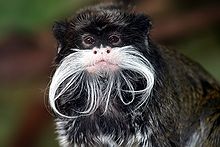Tamarin
| Tamarins | |
|---|---|
 |
|
| Emperor tamarin, a New World monkey | |
| Scientific classification | |
| Kingdom: | Animalia |
| Phylum: | Chordata |
| Class: | Mammalia |
| Order: | Primates |
| Family: | Callitrichidae |
| Genus: |
Saguinus Hoffmannsegg, 1807 |
| Type species | |
|
Saguinas ursula Hoffmannsegg, 1807 |
|
| Species | |
|
18 species, see text |
|
| Synonyms | |
|
|
18 species, see text
The tamarins are squirrel-sized New World monkeys from the family Callitrichidae in the genus Saguinus. They are closely related to the lion tamarins in the genus Leontopithecus.
Different tamarin species vary considerably in appearance, ranging from nearly all black through mixtures of black, brown and white. Mustache-like facial hairs are typical for many species. Their body size ranges from 13 to 30 cm (plus a 25 to 44 cm long tail) and they weigh from 220 to 900 grams. Tamarins differ from marmosets primarily in having lower canine teeth that are clearly longer than the incisors. In captivity, tamarins can live for up to 18 years.
Tamarins range from southern Central America through central South America, where they are found in northwestern Colombia, the Amazon basin, and the Guianas.
Tamarins are inhabitants of tropical rainforests and open forest areas. They are diurnal and arboreal, and run and jump quickly through the trees. Tamarins live together in groups of up to 40 members consisting of one or more families. More frequently, though, groups are composed of just three to nine members.
Tamarins are omnivores, eating fruits and other plant parts as well as spiders, insects, small vertebrates and bird eggs.
...
Wikipedia
